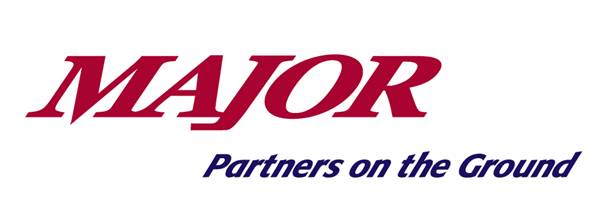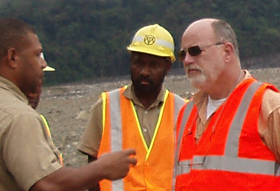Sponsored by: 
Major Drilling Group International, Inc.
 Photo: Mark and colleagues are standing on about 90 m thickness of mine waste in the upper Ok Mani, immediately below Ok Tedi pit and waste rock dumps.
Photo: Mark and colleagues are standing on about 90 m thickness of mine waste in the upper Ok Mani, immediately below Ok Tedi pit and waste rock dumps.
Abstract
Mine wastes at closure typically amount to millions to billions of metric tonnes by mass and occupy hundreds to thousands of hectares of surface, with some structures extending over several hundreds of metres of vertical relief. Regardless of the specific climate of the mine site, reaction rates for sulphide oxidation show that the wastes will remain geochemically reactive for centuries to millenia if exposed to air and water. Additional issues, some related to geochemical ones, arise for geomechanical and geomorphic stability of engineered features and structures. Establishing a coherent basis for determining how far into the future proposed mine-site closure must be effective has too often been neglected.
Engineering structures, including mine structures, are designed to perform with respect to specific design criteria related to material properties and the natural environment, often organized around response to external forces with statistically-defined probabilities of occurring per unit. In engineering, one speaks of “design-basis events” and also considers the risks from “extreme events”, incorporating both into the detailed design criteria for an entire project that ultimately will be defined. The geotechnical conventions deserve to be extended to considerations of geochemistry also.
Mine closure can be considered in terms of three overlapping, but distinguishable periods:
· Construction and active reclamation
· Final reclamation
· Long-term maintenance and monitoring that will document that the expectations for stable slopes with controlled water-quality performance have been met.
Consideration of these periods, the scientific basis for understanding closure risk, and established engineering practice leads us to suggest that a reasonable, total planning period for management of mine wastes should be in the range of 200 to 500 years, and it probably should include a semi-quantitative assessment of whether or not major changes in performance are likely to occur between approximately 500 and 1,000 years. Plans should include (1) identification of risks to surface and ground water in terms of adverse impacts to beneficial uses, (2) presentation of a case that mine-waste structures would be stable with respect to erosion by flooding or deep-seated shear failures, and (3) presentation of a case that reactive wastes as disposed for those periods will remain physically stable.
Biography
Mark Logsdon is a geochemist with 40 years of experience in geology, hydrogeology, and environmental chemistry related to mining and mine-waste management. He is a graduate of Princeton and has work experience that includes teaching, mine-exploration geochemistry, government service, research, and consulting. Since 1984, Mark has been in private consulting, focusing on mining issues, particularly (a) acidic and metalliferous drainage; (b) water-quality conditions in natural and mined ground, including surface and ground-waters; (c) planning for and executing mining exploration, development, operations, closures, and remediation/restoration. Such assessments typically involve not only geochemistry, but also the underlying geology and mineralogy and the relationships of hydrogeology, mining and site-engineering practices and costs. Mark has worked on more than 250 mining projects, including metal and nonmetal mines in the U.S.A., Canada, Mexico, Guatemala , Honduras, Argentina, Brazil, Chile, Columbia, Peru, Venezuela, Ireland, France, Portugal, Russia, Spain, Guinea, Mozambique, South Africa, Tanzania, Australia, Laos, Mongolia, New Zealand, Indonesia, Papua New Guinea, and the Philippines.